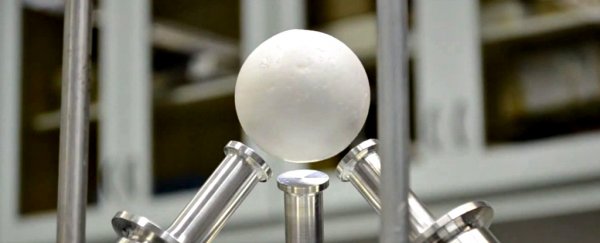Researchers have successfully levitated a 50-mm (2-inch) solid polystyrene ball using nothing but high frequency sound waves.
Although scientists have been able to acoustically levitate small objects such as water droplets for years, this is one of the largest spheres that's ever been floated in mid-air using the power of sound.
Acoustic levitation works by using opposing beams of sound waves to create a standing waves. These standing waves have peaks that oscillate between high and low pressure, and can be used to bounce and jostle an object up against the force of gravity.
Usually this is done with two opposing sound waves, and water droplets or tiny polystyrene balls smaller than the acoustic wavelength.
The traditional technique is to trap the object in the pressure node - the sweet spot where the pressure of the standing wave doesn't change at all - so that the standing wave below the object works like a ping pong paddle, constantly hitting the object upwards.
But this is the first time acoustic levitation has been done with a sphere that's 3.6 times larger than the acoustic wavelength, and has a mass of around 1.5 grams.
 Andrade et al./AIP Publishing
Andrade et al./AIP Publishing
Using the traditional technique, it was thought that the maximum sized object that could be levitated using ultrasound waves, which have a frequency about 20 kHz and a wavelength of 14 mm, was around 4 mm in diameter.
"In our paper, we demonstrate that we can combine multiple ultrasonic transducers to levitate an object significantly larger than the acoustic wavelength," one of the researchers, Marco Andrade from the University of São Paulo in Brazil, told Lisa Zyga over at Phys.org.
"We could increase the maximum object size from one quarter of the wavelength to 50 mm, which is approximately 3.6 times the acoustic wavelength."
To pull this off, the team used a tripod structure of ultrasound transducers.
Instead of trapping the object at the pressure node - the ping pong bat method isn't powerful enough to levitate something this large - the team generated a standing wave between the transducers and the object. This meant the sphere was being buffered on three sides by sounds waves to hold it in place.
Using this technique, they were able to levitate the sphere to a height of around 7 mm, which is approximately half the wavelength of acoustic waves.
But the researchers hope that by tweaking their technique, they'll be able to get objects higher - and also levitate larger objects at different angles.
"At the moment, we can only levitate the object at a fixed position in space," Andrade told Phys.org. "In future work, we would like to develop new devices capable of levitating and manipulating large objects in air."
Acoustic levitation could play an important role in the future to analyse and control liquid in space, as well as helping researchers handle extremely hot or caustic materials here on Earth.
It could also help researchers to one day generate Star Trek-style tractor beam devices, that can pull an object towards them.
More importantly for now, it just looks really, really cool.
For even more acoustic levitation on the small scale, check this out:
The research has been published in Applied Physics Letters.
